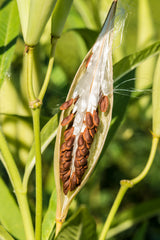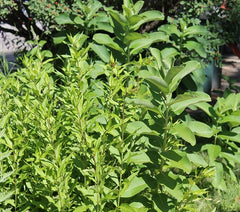 Milkweed grows in a sturdy upright pattern with large leaves that turn from light green to dark green and sometimes to red as they mature. The plant can reach up to six-feet tall and produces a multi-clustered pinkish purple flower that is typically as large as a tennis ball and blooms throughout the summer, if regularly pruned. In addition to Monarchs, many other pollinators will visit these flowers so this plant does well if combined with other flowering plants. If leaves or stalks are broken, they ooze a white, milky substance which gives the plant its name. Large oblong seed pods eventually form with a hard husky shell and are often used in dried floral arrangements. When broken open, the silky seeds will float all over and can be a bit messy.
Milkweed grows in a sturdy upright pattern with large leaves that turn from light green to dark green and sometimes to red as they mature. The plant can reach up to six-feet tall and produces a multi-clustered pinkish purple flower that is typically as large as a tennis ball and blooms throughout the summer, if regularly pruned. In addition to Monarchs, many other pollinators will visit these flowers so this plant does well if combined with other flowering plants. If leaves or stalks are broken, they ooze a white, milky substance which gives the plant its name. Large oblong seed pods eventually form with a hard husky shell and are often used in dried floral arrangements. When broken open, the silky seeds will float all over and can be a bit messy.
 Milkweed requires full sun, light soil, and can handle drier conditions once established. This plant is also perennial (assuming you choose a variety native to your region) and spreads rapidly through a rhizome or taproot growing out from the plant. Planting just a few plants this year will eventually help you establish a large patch over time and will require some cutting back if it outgrows your flowerbed. While Milkweed will not fit every landscape design, there are many ways to include this amazing plant in your garden. Be creative and put the plant’s tall, sturdy structure to use to complement other more delicate plants. Here are just a few ideas to get you started:
Milkweed requires full sun, light soil, and can handle drier conditions once established. This plant is also perennial (assuming you choose a variety native to your region) and spreads rapidly through a rhizome or taproot growing out from the plant. Planting just a few plants this year will eventually help you establish a large patch over time and will require some cutting back if it outgrows your flowerbed. While Milkweed will not fit every landscape design, there are many ways to include this amazing plant in your garden. Be creative and put the plant’s tall, sturdy structure to use to complement other more delicate plants. Here are just a few ideas to get you started:
Cottage Garden Design
 The best and easiest way is to plant a cottage-style garden. These freeform gardens typically include hardy plants such as Hollyhocks, Tall Garden Phlox, Climbing Roses, and Daisies and it’s easy to tuck a few Milkweeds into that mix. As the summer goes, each plant will flower, inviting birds and butterflies from all over. Monarchs will feed from many different plants and you’ll most likely attract lots of other beneficial insects who’ll work hard to pollinate your garden or fruit trees.
The best and easiest way is to plant a cottage-style garden. These freeform gardens typically include hardy plants such as Hollyhocks, Tall Garden Phlox, Climbing Roses, and Daisies and it’s easy to tuck a few Milkweeds into that mix. As the summer goes, each plant will flower, inviting birds and butterflies from all over. Monarchs will feed from many different plants and you’ll most likely attract lots of other beneficial insects who’ll work hard to pollinate your garden or fruit trees.
Create a Corridor Rest Stop
Just a few plants placed together in a corner of your yard are enough to support quite a few Monarchs over the summer. Try a grouping around your mailbox or in an out-of-the-way strip such as along the back of your garage or near an alley. Because these plants are so hardy, you don’t have to worry about keeping them watered like many regular landscaping plants. And they’ll regrow from year to year so once you plant, you’ll always have milkweed for the Monarchs.
Go Big!
If you have a pasture, a roadside piece of land, or just an extra large backyard, consider building up a “native prairie” in your corner of the world. Start with lots of milkweed and add in other favorites pollinators such as Purple Coneflower or Black-Eyed Susans. Your local Extension office can help you pick out the right plants for your area, assist you to draw up a plan, and probably even help you source and buy the plants and seeds.
Get Milkweed for your garden here
Want to learn more about Monarchs? Click over to our article, “America’s Favorite Butterfly.”
.
